Yakking with Yoko
- Published
- comments
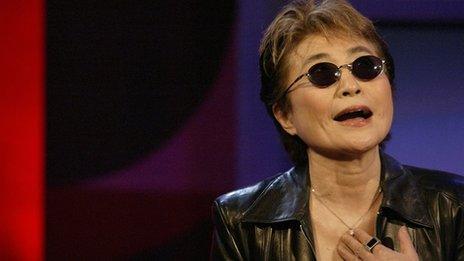
In 1964 Yoko Ono made her first masterpiece - that was nearly half a century ago.
She was a 31-year-old Japanese artist living in New York running with the city's super-hip avant-garde crowd. People like Robert Rauschenberg, external, Claes Oldenburg, external and John Cage, external. Sometimes Marcel Duchamp, external - the wise and whimsical father of conceptual art - would come by to see what his progeny were up to.
I don't know if he saw Ono's Cut Piece, but I think he would have liked it if he had. This is a video of Ono performing the work, external, in which she sits on the floor of a stage wearing a black dress with a pair of scissors in front of her. She then invites the audience to come up onto the stage and cut her dress with the scissors until she is naked. She remains inscrutable and still throughout.
She says the work is "expressing the path women go through in life".
You don't really need me to explain why she performed it less after marrying John Lennon.
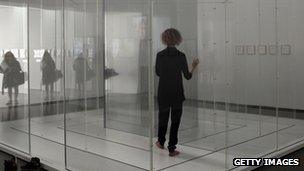
Amaze by Yoko Ono
I had hoped she would reprise the work for her show at The Serpentine Gallery, external which opens today, but she is not. Fair enough. After all she is 79-years-old - although she looks younger.
I was pleased to meet her. I know she annoys - and has annoyed - plenty of people, but not me. I've long been a fan of her early work and intrigued by her story. She was in the eye of the artistic storm throughout the 60s and 70s - there where it counted, and still does.
Not everything she has said and done since has been great - but then who gets everything right for 30 or so years without making a single mistake?
I asked her what she thought her current reputation might be.
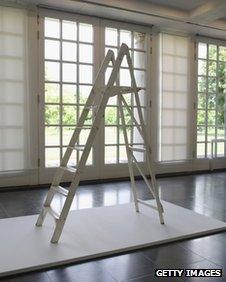
Ceiling Painting by Yoko Ono
She said, "I don't know," but had noticed that she was being offered "more and more shows in art galleries".
Time has healed. Yoko Ono is hip once more (and popular with over 2.4 million Twitter followers, external).
She was nervous when talking about her work until the conversation moved onto Cut Piece. Then she relaxed. "It influenced all my [future] work," she said.
Was it inspired by Marcel Duchamp and her Manhattan-based avant-garde mates?
Not so much she said. It came more from her Japanese roots and an exploration of Eastern spirituality.
Did audiences react in the same way wherever she performed it? "In Japan and America yes," she said. "They were very respectful and caring."
And then she laughs. "It was different in England."
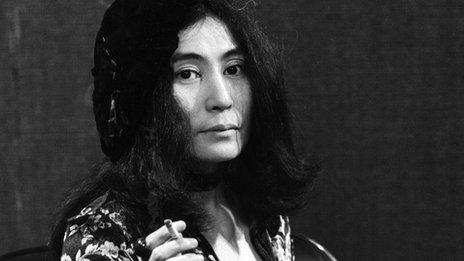
Oh?
"Twenty guys came up and I was naked immediately!"
And that was before she married John Lennon. About whom she talks a lot.
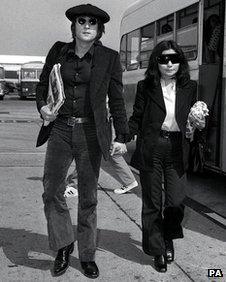
About the time they first met in the mid-60s at her London show when he had walked up a white ladder she had installed to take hold of a magnifying glass on the ceiling with which to read a tiny piece of text - also on the ceiling - that read "yes".
He liked it because it was life-affirming and positive and didn't involve smashing up pianos, which was the tendency among her Fluxus group, external.
John Lennon called it right.
She said the work was a response to a bad time she was having in her life - "personal matters". It was designed to cheer her up. To help her survive.
And the next time they met…?
"…was in New York." At another of her shows, where he arrived with a hat pushed down over his head and scarf up to his eyes, through which he would only grunt.
"I could tell you the whole story but that would be a book and I'm not giving you that." So spoke a veteran interviewee. Good stories make good books - make good money.
Yoko Ono: Now the door is suddenly open, I don't know what to do with it
I wondered if she was annoyed by what happened to her. That one day she was a respected artist and the next she was the wife of a Beatle and being accused of splitting the band up.
I expected to hear about 40 years of frustration, of being misunderstood and artistically overlooked. But she couldn't care less. Actually, she preferred it that way.
"I was becoming an [art world] grande dame," she said as if it was code for a heinous crime. When she married Lennon all that reverence disappeared.
That's not to say the vitriol wasn't a surprise. They had assumed that because she was popular in her professional world and Lennon popular in his, that all would bless their marriage.
Was there a racial aspect in the negativity to their nuptials?
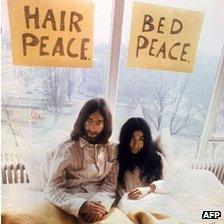
She thinks so. Explaining that they had not given any thought to the recent past when their respective countries had been at war. But when the trickle of bad press became a flood they spent some time reflecting on the cause and concluded that war was the reason some took a negative view of their relationship.
So, they used their fame to promote peace and love and their artworks (some of which she has kept going and can be seen in the Serpentine show). As we wrap up I ask who her favourite artists are. Without hesitation she says "me!"
I inwardly wince, but record it again for good measure. She is happy to comply.
And why not? She is only being honest.
But it jars.
That's why some people like Yoko Ono and some people do not.